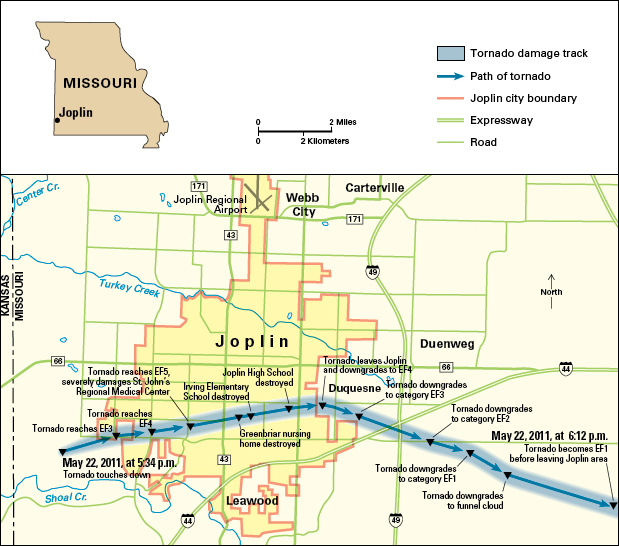Joplin tornado of 2011 was one of the deadliest tornadoes in United States history. It struck Joplin, in southwestern Missouri , on May 22, 2011. It killed about 160 people and destroyed thousands of homes and other buildings.

In the early evening of Sunday, May 22, a supercell thunderstorm —the most destructive category of thunderstorm—moved from southeastern Kansas to southwestern Missouri. Supercell thunderstorms produce large hail, strong winds, and powerful tornadoes. At 5:17 p.m., the National Weather Service issued a tornado warning for the entire Joplin area. At 5:34 p.m., a tornado touched down southwest of Joplin.
As the tornado entered Joplin, its wind speeds quickly exceeded 200 miles (320 kilometers) per hour. The entire path of the tornado, which died out east of Joplin, was about 22 miles (35 kilometers). It ranged from 1/2 mile to 1 mile (800 to 1600 meters) in width.
On the Enhanced Fujita scale, the scale used to classify tornadoes, the Joplin tornado measured EF4 and EF5—the two strongest ratings. The EF4 and EF5 portions of the tornado traveled about 6 miles (9.7 kilometers) through the heart of the city. See Tornado (table: The Enhanced Fujita scale) .
Officials reported that about 160 people died, and more than 1,000 were injured. More than 7,000 homes were destroyed or damaged. Many major buildings—including a hospital and several schools, stores, churches, and power substations—were leveled or suffered major damage. Insurance experts estimated that the tornado caused more than $2 billion in damage.
Joplin residents, with the help of volunteers and government agencies, quickly began to rebuild the city. The disaster gained international attention, and individuals and governments from around the world sent donations to help the people of Joplin.
Two days after the Joplin tornado, tornadoes in Oklahoma, Kansas, and Arkansas killed 18 people.
See also Thunderstorm ; Tornado .
